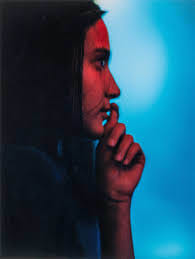Having studied Microbiology at Bristol University in 1978, Graham left the science world and became a key player in the revolutionary movement known as New British Documentary photography. Photographing in colour, Graham uses his camera to expose the things we overlook.
In 1982, Graham published A1-The Great North Road, a series of colour photographs taken along the A1, the first road to run the entire length of the England. Influenced by Thatcher's economic policies, Graham surreptitiously photographed unemployment offices in Beyond Caring (1984-1985), capturing the masses left to fend for themselves in a climate of economic crisis. Despite claims that this was voyeuristic exploitative art, Graham was very clear with his intent. He said, "At the end of the day you have to arrive at a justifiable moral position, whether what you intended doing with the pictures is worthwhile. You have to think about the value these pictures might have in a documentary sense... and weigh up those things against the possible objections if someone who you happen to have caught on film." (Paul Graham, Man with a Moving Camera, an Interview with Paul Bonaventura, Artefactum 3, 1994, 7-8).
In addition to exhibiting in MOMA's 1987 exhibition, New Photography 3 and the publication, the series had far reaching influence extending beyond the art world. The photographs toured with the greater London Council to TUC Conferences and to the Citizen's Advice Bureau. In addition, the photographs were republished in literature by pressure groups including Poverty and Christian Action to lobby MPs for better conditions in unemployment benefit offices. The photographs were also featured in a BBC news program, "The World at One".
According to Art Historian David Chandler, If Beyond Caring was motivated by and located in places very close to Graham's own experiences, Troubled Land was its antithesis, a series that drew him, emotionally and politically, into unknown territory. (David Chandler, Paul Graham: Photographs 1981-2006, 2009, 31) In 1984, Graham went to Northern Ireland to photograph the conflict there and created Troubled Land to depict the Troubles without reinforcing the media's clichéd and stereotypical representation of the violence. The resulting publication, Troubled Land, was instrumental in fostering a new school of British photography that was both in colour and politically engaged.
More recently, Graham has turned his camera to the inequalities that persist throughout American society. In American Night (1998-2000), Graham explored injustices faced throughout US society by juxtaposing overexposed washed out images with those in vivid colour. American Night, simultaneously explores American culture, but also challenges the meaning of photographic representation and the medium itself. Between 2004-2006, Graham created his most recent body of work, shimmering nights that explores the gap between photography, conceptual art and cinematography.
Graham was featured in a number of solo and group exhibitions throughout the UK and abroad. In 2009, Graham exhibited A Shimmer of Possibility at the Museum of Modern Art, New York and a mid-career retrospective at Folkwang Museum Essen (2009) which travelled to the Deichtorhallen Hamburg (2010-2011) and the Whitechapel Gallery, London (2011) entitled Paul Graham: Photographs 1981-2011. Graham was awarded the Deutsche Borse Photography prize in 2009.
Graham's photographs can be found in private and public collections including The Victoria and Albert Museum, The Tate Gallery, The Whitney Museum, New York, The Guggenheim Museum, New York, The Museum of Modern Art, New York, and the Stedelijk Museum, Amsterdam among others.
